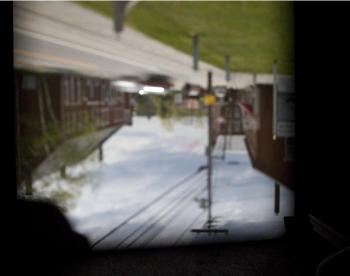SEARSPORT — September’s Mini Maker Faire in Camden produced some wonderfully strange inventions, but perhaps most noticeable was a large, brown, square structure on the street, something looking like a tool shed with an accordian-shaped facade. It was, in fact, a giant camera obscura, or pinhole camera, designed by John Bielenberg and constructed by him with the help of carpenter Richard Mann.
“It was created last summer for Penobscot Marine Museum’s Magic of Photography exhibit,’ said Kevin Johnson, Penobscot Marine Museum’s photo archivist.
There’s a small door to the walk-in camera. Inside there are benches on either side that can accommodate up to 10 people. On a sunny day, the only light to come in from a 1-½ inch aperture reflects on a white screen on the opposite wall. Once inside the camera and your eyes adjust, watching the images come through the aperture seem like you’re watching a a silent movie. Only...something’s off.
“It’s very educational, because once inside you see how a camera actually sees the world, which is upside down and backwards,” said Johnson.
“A camera obscura is the Latin word for ‘dark room,’” he said. “It’s a natural effect. It wasn’t invented. It was discovered nearly 2,000 thousand years ago, that light passing through a pinhole produces an inverted image on the opposite wall of a darkened room."
An experienced photographer with vintage cameras himself, Johnson explained how it worked. “Rays of light travels in a straight line, so light reflected off the sky is reflected in a downward angle and light reflected off the ground is reflecting back up. Believe it or not, your eyes actually see the world the same way as this upside down backward image on the wall. Your pupil is the pinhole, but your brain corrects the image so that it is right side up.”
Camera obscuras are not new. They were created as simply a box with a tiny aperture to let in daylight.
“They didn’t have a way to capture images at the time, but it was used extensively by Italian Renaissance painters to trace the landscape upon paper or canvas,” said Johnson. “They desired to capture perspective and depth-of-field to pinpoint accuracy. Then, they’d take the paper and turn it right side up again and use that to create their art.”
With any invention, there’s a bit of trial and error. “When we first constructed this piece, we had an aperture the size of a dime and the images projected upon the wall were incredible sharp,” he said. “But you’d have to sit here about 15 minutes before your eyes could properly see the images.” Carving out a slightly larger aperture sped up the time the human eye could register the images.”
Johnson said the camera was a huge hit at the Mini Maker Faire and was full from start to finish. The only thing they didn’t think about is how hot it would get inside. “When we constructed it the winter of 2015, we weren’t thinking it would be a sauna in the warmer months,” he joked.
The giant camera had to be specially moved by Belmont Boatworks using a crane and boat trailer and has now been re-positioned back on the front lawn of the Penobscot Marine museum in Searsport for the remainder of the season, which ends Oct. 17. Johnson is hoping to find funding for a custom trailer for the structure, so it can be moved to travel to schools, festivals and fairs.
For more information about Penobscot Marine Museum’s past photography exhibits visit: Penobscot Marine Museum/Photograph
Kay Stephens can be reached atnews@penbaypilot.com































